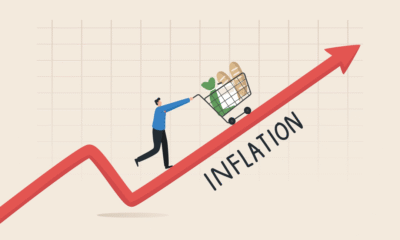Economics
Navigating Economic Turbulence: China’s Property Market and Export Slowdown

Introduction to China’s Economic Landscape
China’s economy has long been viewed as a powerhouse, characterized by rapid growth and significant global influence. However, the current economic landscape presents a series of challenges that merit closer examination. Several factors contribute to the headwinds facing China today, including both domestic policies and international developments. The interplay between these elements will be crucial in understanding the complications surrounding China’s property market and export dynamics.
On the global stage, ongoing geopolitical tensions and trade disputes have created volatility in international markets, thereby impacting China’s export-oriented growth model. The slowdown in global demand has been pronounced, resulting in diminished external trade performance—a critical component of economic stability for China. Furthermore, rising inflation rates and interest hikes in major economies, particularly in the United States and Europe, further complicate prospects for Chinese exports.
Internally, China is grappling with various structural issues that have arisen from years of aggressive urbanization and real estate investment. The advent of debt-laden property developers has led to instability within the real estate sector, causing widespread concern about the potential implications for financial markets and consumer confidence. Additionally, regulatory reforms aimed at curbing speculative buying have inadvertently contributed to the cooling of property demand, further affecting economic growth.
Moreover, the government’s zero-COVID policy has disrupted supply chains, complicating China’s economic recovery post-pandemic. As manufacturers faced lockdowns and logistical challenges, the efficiency and productivity of crucial industrial sectors were adversely impacted. Consequently, understanding the current economic conditions in China requires a multi-faceted approach, considering both external pressures and internal policy shifts that serve to influence its growth trajectory.
The Property Market Crisis: An Overview
The property market in China is currently experiencing a significant crisis, characterized by oversupply, declining sales, and escalating debt levels among property developers. Historically, the rapid urbanization and industrialization in China spurred a construction boom, resulting in an excess of residential projects. This phenomenon has led to a situation where demand has not kept pace with supply, culminating in a surplus of unsold properties across numerous cities.
In recent years, stricter regulation and financial constraints imposed by the government have further exacerbated the crisis. The introduction of measures aimed at curtailing speculative investments and controlling borrowing has left many developers with insufficient liquidity to continue their operations. As a result, numerous property companies are grappling with substantial debt levels, putting them at risk of defaults. This precarious financial situation has made it increasingly difficult for businesses to procure new projects, leading to a slowdown in construction activities.
Alongside financial constraints, there has been a noticeable plummet in property sales, heavily influenced by waning consumer confidence. Prospective buyers are adopting a cautious approach, driven by rising concerns over the economic outlook and potential risks associated with purchasing real estate. This shift in consumer behavior plays a critical role in the market’s dynamics, as it not only affects individual developers but also has broader implications for the economy as a whole.
The repercussions of the property market crisis are significant, extending beyond the construction sector to impact various related industries, such as steel, cement, and home furnishings. Additionally, the slowdown in the property market can lead to decreased local government revenues, further straining public finances. As such, the challenges faced by the property sector serve as vital indicators of the state of China’s overall economy, underscoring the interconnectedness between real estate, consumer confidence, and economic stability.
Government Interventions and Policies
The Chinese government has been proactive in addressing the challenges within the property market, particularly in response to a crisis marked by defaults and decreased buyer confidence. To mitigate the impact of economic turbulence, the government has employed various monetary and fiscal policies aimed at stabilizing the housing sector and fostering a conducive economic environment.
One of the primary actions taken includes interest rate adjustments. In recent months, the People’s Bank of China (PBOC) has lowered benchmark interest rates to make borrowing more attractive. This move encourages homebuyers and investors to enter the market, thereby stimulating demand. Lower interest rates can enhance affordability and potentially revive sales in what has become a stagnant property landscape.
Additionally, the government has implemented specific lending restrictions to safeguard financial institutions from excessive risk. While tighter regulations have been instituted to prevent over-leverage, recent adjustments aim to relax certain restrictions on mortgage lending, allowing individuals and developers greater access to funding. This adjustment is seen as crucial in reigniting growth in an industry that has faced severe scrutiny regarding its sustainability.
Fiscal policies have also played a significant role in addressing the property market crisis. The government has introduced stimulus packages intended to bolster construction activities and provide support to struggling property developers. These packages often include cash injections, tax breaks, and the acceleration of infrastructure projects, which not only stimulate job creation but also bolster related sectors, such as manufacturing and supplies.
The effectiveness of these interventions remains subject to debate. Some analysts argue that while targeted policies have provided temporary relief, significant structural challenges within the property market necessitate deeper reforms. It is essential for the Chinese government to navigate these complexities carefully to achieve long-term stability.
The Export Slowdown: Causes and Effects
China’s export sector has experienced a notable slowdown, spurred by various intertwined factors that reflect both domestic and global circumstances. At the forefront of these challenges are escalating trade tensions, particularly between China and the United States. The imposition of tariffs and trade barriers has disrupted traditional supply chains, with manufacturers facing increased costs and diminished competitiveness in international markets.
Additionally, the global economic landscape has been plagued by uncertainty, significantly impacting demand for Chinese goods. The repercussions of the COVID-19 pandemic have reverberated across economies worldwide, leading to reduced consumer spending, diminished investment, and a slowdown in manufacturing. These factors have collectively resulted in a contraction of demand for exports, making it increasingly difficult for Chinese businesses to maintain their previous growth trajectories.
Data from the first half of 2023 indicates that China’s exports shrank by approximately 15% year-on-year, a staggering decline attributed to reduced shipments to major partners such as the United States and Europe. This downturn has severely affected various industries, including electronics, textiles, and machinery, all of which are crucial to China’s economic framework. Many companies have been forced to pivot their strategies, seeking new markets or adapting their production capabilities to fit the changing demands.
The ripple effects of the export slowdown are extensive. As exports dwindle, domestic manufacturing suffers, leading to potential job losses and further economic strain within China. Local economies that rely heavily on export-driven industries face increased pressure, prompting authorities to investigate and implement measures to stimulate growth. Understanding the intricacies of these challenges is vital for policymakers and business leaders as they navigate an increasingly complex economic landscape.
Impact on Employment and Income Levels
The persistent challenges faced by China’s property market and the slowdown in exports are having significant repercussions on employment and income levels within the country. The real estate sector, traditionally a major contributor to job creation, is currently experiencing a downturn. As developers face financial difficulties and project cancellations rise, a considerable number of workers, including those in construction, engineering, and related industries, are facing layoffs. Reports indicate that job losses in these sectors have led to an overall increase in unemployment rates, posing long-term challenges for the economy.
Moreover, the reduction in property-related jobs has instigated a ripple effect across many other sectors. With decreased demand for housing and construction materials, ancillary industries are witnessing a contraction, resulting in further layoffs. Consequently, this trend is leading to a decline in labor demand across various sectors. As job security diminishes, individuals and families are experiencing heightened uncertainty regarding their financial futures.
In addition to employment losses, the interplay between diminished income levels and reduced job opportunities is increasingly problematic. Individuals who are fortunate enough to remain employed may still face stagnant wages, limiting their purchasing power. The effect of lower income levels extends into consumer spending, which is critical for stimulating economic growth. As households tighten their budgets due to fears of unemployment and economic instability, discretionary spending decreases sharply. This fall in consumer confidence and expenditure poses significant challenges to the broader economic landscape, further exacerbating the overall economic slowdown.
Addressing these interconnected issues will require strategic interventions from government bodies and the private sector. Efforts to stimulate job creation, coupled with initiatives aimed at revitalizing both the property market and export activities, will be essential in stabilizing employment and restoring income levels to foster economic recovery in China.
Challenges for Small and Medium Enterprises (SMEs)
Small and medium enterprises (SMEs) play a crucial role in fostering economic growth and innovation; however, they are facing significant challenges in the current economic landscape shaped by China’s property market instability and export slowdown. One of the foremost issues confronting SMEs is their reduced access to financing. Many financial institutions, observing the potential risks associated with the economic climate, have tightened lending criteria. This stringent approach limits SMEs’ ability to secure essential funds required for operations, expansion, and innovation.
In addition to financing challenges, SMEs are grappling with decreased consumer demand across various sectors. The economic turbulence has led consumers to reassess their spending habits, causing a marked decline in demand for non-essential goods and services. This decline directly impacts SMEs reliant on a steady flow of customers, forcing them to rethink their business strategies in order to adapt to shifting market conditions.
Moreover, competitive pressures have intensified as larger corporations, equipped with more substantial resources, are better positioned to absorb the economic shocks. These larger entities can offer lower prices and more enticing promotions, putting SMEs at a disadvantage. This situation not only threatens the survival of SMEs but also impedes their ability to contribute to economic diversity and innovation. The constant need to innovate and differentiate becomes increasingly challenging for SMEs functioning within a constrained economic environment.
These compounded challenges present a broader threat to the landscape of entrepreneurship and economic resilience. Without adequate support systems and resources, SMEs may struggle to navigate these challenges effectively, thereby affecting their sustainability and contribution to the economy. Addressing these issues is vital, as SMEs are often the backbone of economic diversity, innovation, and job creation.
Future Outlook: Opportunities Amidst Challenges
In the context of China’s current economic turbulence, characterized by a property market crisis and export slowdown, it is vital to identify sectors that present opportunities for growth and resilience. Despite the prevailing challenges, certain industries have managed to thrive or adapt effectively to the changing landscape. For instance, the technology sector continues to demonstrate robust performance, driven by the increasing demand for digital solutions, artificial intelligence, and e-commerce platforms. As more consumers shift towards online shopping and remote services, companies in these fields are poised for expansion.
Moreover, the healthcare and biotechnology sectors are experiencing growth due to heightened awareness around public health and wellness, coupled with the ongoing global health challenges. These industries not only provide essential services but also catalyze innovation in medical technology, creating potential investment opportunities for stakeholders seeking to navigate the economic downturn effectively.
An important aspect that may shape the future outlook is the shifting consumer behavior in response to economic pressures. As households become more budget-conscious, there is an increasing preference for value-driven products and services. This trend could benefit companies that are able to offer quality goods at competitive prices without compromising on essential features. Simultaneously, a strong emphasis on sustainability is emerging, leading to opportunities for businesses that innovate around eco-friendly products and practices.
Furthermore, government policies aimed at stabilizing the economy and nurturing long-term resilience will play a crucial role in shaping the future. Initiatives focused on infrastructure investment, green energy projects, and support for small and medium enterprises can help revitalize key sectors and create a more sustainable economic environment. By harnessing these opportunities and adapting to consumer needs, businesses can position themselves favorably amid the economic turbulence.
Comparative Analysis with Other Economies
As China grapples with significant economic challenges, particularly in its property market and export sector, drawing comparisons with other major economies can provide valuable insights. Historical downturns in economies such as Japan during the 1990s or the United States following the 2008 financial crisis reveal recurring themes in dealing with economic turbulence. These case studies highlight both the unique parameters impacting China and the lessons that can be gleaned from the experiences of other nations.
Japan’s economic stagnation, known as the “Lost Decade,” illustrates the potential dangers of an overheated real estate market. During the late 1980s, Japan saw soaring property prices, followed by a sharp decline that precipitated a long period of economic malaise. China’s current property market issues bear similarities; however, the Chinese government employs different strategies, such as targeted monetary policies and regulatory measures, to mitigate the downturn. Observing Japan’s experience underscores the importance of timely intervention to stabilize the property market before it can spiral into a broader economic crisis.
Similarly, the United States’ recovery post-2008 offers several lessons regarding response strategies to economic slowdown. Fiscal stimulus packages and a re-evaluation of financial regulations played crucial roles in revitalizing the economy. In contrast, China has predominantly relied on infrastructure spending and export-driven policies. This difference in approach signals a potential area where China might adapt its strategies to include more diversified and sustainable growth models that are less dependent on property and exports.
In summary, while China’s current economic challenges are distinct, the experiences of other economies provide useful frameworks for understanding potential recovery paths. By examining the similarities and differences in these situations, policymakers can better navigate the complexities of China’s economic landscape, leveraging both successful strategies and avoiding past mistakes. This comparative analysis serves as a foundation for fostering resilience amid ongoing economic uncertainty.
Conclusion: Navigating the Path Forward
As we reflect on the current state of China’s property market and the slowing export sector, it becomes evident that these economic challenges necessitate a comprehensive understanding of the underlying dynamics at play. The interconnection between the property market and export performance has created a complex landscape for stakeholders, including policymakers, investors, and businesses. Acknowledging these conditions is pivotal for informed decision-making moving forward.
Investors should remain vigilant and consider diversifying their portfolios to mitigate risks associated with potential downturns in the property market. This may involve exploring alternative investment opportunities both domestically and internationally. In addition, engagement with local authorities and understanding government policies can provide valuable insights for adjusting investment strategies in response to changing market conditions.
For policymakers, the focus must be on implementing measures that foster stability in the property sector while stimulating export growth. Strategies may include targeted financial incentives to boost demand or regulatory reforms aimed at enhancing the business environment. Effective communication with stakeholders will also be crucial in building confidence and ensuring transparency during times of uncertainty.
Businesses must prioritize adaptability, remaining agile in a fluctuating economic environment. Reevaluating supply chains and operational strategies to reduce dependence on volatile sectors can provide a buffer against future disruptions. Collaboration and innovation will play key roles in navigating this landscape, as businesses that effectively leverage technology and develop robust networks are likely to weather the storm more successfully.
In conclusion, navigating economic turbulence requires a proactive approach grounded in strategic planning and adaptability. By recognizing the risks and opportunities within China’s property market and export sector, stakeholders can better equip themselves to traverse the path ahead with resilience and foresight.
Finance & Investment
Trade Surveillance in Banking: Lessons from JPMorgan’s $348 Million Fine

Trade surveillance is a critical compliance function in banking and financial services that ensures the integrity of market activities and adherence to regulatory requirements. Effective trade monitoring helps prevent market abuses such as insider trading, front-running, and manipulation, protecting both investors and the broader financial system. Recently, JPMorgan Chase faced a substantial $348 million fine imposed by the Federal Reserve and the Office of the Comptroller of the Currency (OCC) due to inadequate trade surveillance controls. This high-profile penalty serves as a stark reminder to banks worldwide about the vital need for robust monitoring systems. Trade surveillance involves collecting and analyzing massive volumes of trading data in real time to identify suspicious behaviors or patterns that may indicate misconduct. As markets become more complex and trading volumes grow exponentially, financial institutions must invest heavily in surveillance technologies and governance frameworks to meet evolving regulatory expectations and safeguard their reputations.
The JPMorgan Case: What Went Wrong?
JPMorgan Chase’s penalty arose from several shortcomings in its trade surveillance program. Regulators found that the bank’s monitoring systems failed to adequately cover all trading venues and did not effectively analyze the full range of data needed to detect potential misconduct. Gaps in oversight allowed certain trading activities to go unchecked, increasing the risk of market abuses. Additionally, the bank’s controls were insufficient in preventing or identifying misconduct promptly, which is crucial for timely investigation and remediation. These deficiencies pointed to weaknesses in both technology infrastructure and internal governance. The case highlighted the consequences of inadequate surveillance, not only in terms of financial penalties but also reputational damage and potential loss of client trust. For financial institutions, the lesson is clear: trade surveillance cannot be an afterthought but must be a comprehensive, continuously updated program integral to daily operations.
Best Practices for Effective Trade Surveillance Systems
To avoid costly penalties and operational risks, banks need to implement trade surveillance systems that are robust, scalable, and adaptive. Best practices include integrating advanced analytics capable of processing large data sets across multiple trading platforms in real time. Machine learning and artificial intelligence technologies are increasingly being used to improve anomaly detection, reduce false positives, and provide compliance teams with actionable insights. Comprehensive surveillance programs also require strong governance frameworks that ensure clear roles, responsibilities, and accountability within the institution. Regular audits and continuous improvement cycles help identify gaps and adapt to new market practices or regulatory changes. Employee training and cultivating a compliance-oriented culture are equally important to ensure that staff understand surveillance requirements and actively support adherence. Transparency in reporting and effective communication with regulators can further enhance a bank’s ability to manage compliance risks proactively.
Technology’s Role in Enhancing Trade Surveillance
The complexity of modern financial markets demands that trade surveillance leverages cutting-edge technology solutions. Automated systems can monitor millions of trades, cross-referencing data from various sources such as order books, messaging systems, and market data feeds. AI-powered algorithms identify suspicious patterns that human monitors might miss and prioritize alerts for compliance teams to investigate. These technologies not only improve detection speed but also help reduce the burden of manual reviews, allowing staff to focus on high-risk cases. Additionally, cloud computing and big data architectures enable scalable storage and processing power essential for handling the volume and velocity of trade data. Implementing these technological advancements positions banks to meet stringent regulatory standards while maintaining operational efficiency and competitive advantage.
Strategic Takeaways for Banks and Financial Institutions
The JPMorgan fine underscores that trade surveillance is a critical area where banks cannot afford complacency. Financial institutions must treat compliance as a strategic priority, allocating sufficient resources to technology, people, and processes. Proactive investment in surveillance infrastructure not only reduces the risk of regulatory penalties but also enhances trust among clients and investors. Moreover, comprehensive trade monitoring helps detect internal control weaknesses and potential operational risks early, preventing larger issues. Institutions should conduct regular risk assessments to identify vulnerabilities and tailor surveillance parameters accordingly. Collaboration with regulators and industry groups can provide insights into emerging threats and best practices. Ultimately, integrating trade surveillance into the core of banking operations fosters a culture of integrity and resilience that benefits the institution and the financial markets as a whole.
Conclusion: Compliance as a Competitive Advantage
In conclusion, the JPMorgan Chase $348 million fine serves as a powerful cautionary tale for the banking sector, emphasizing the critical importance of effective trade surveillance. As financial markets evolve and regulatory scrutiny intensifies, banks must invest in sophisticated monitoring systems supported by advanced analytics and a strong compliance culture. Trade surveillance is not merely a regulatory obligation but a strategic tool that protects market integrity, strengthens client relationships, and mitigates operational risks. By learning from high-profile cases like JPMorgan’s, financial institutions can enhance their surveillance capabilities, avoid costly fines, and maintain their competitive edge in a complex and rapidly changing industry landscape. For banks committed to excellence, compliance and innovation must go hand in hand to build sustainable, trustworthy financial services for the future.
Economics
Asia’s Private Credit Boom: What It Means for Retail Investors

The Asia Pacific region is witnessing an extraordinary surge in private credit, transforming the financial landscape significantly. Private credit refers to direct lending to companies outside public markets, and over the last decade, this sector’s assets under management have grown from around $500 million to nearly $2 trillion. This rapid expansion is largely driven by emerging markets such as India and Australia, where businesses increasingly seek alternative financing solutions beyond traditional bank loans and public debt offerings. Historically, private credit has been dominated by institutional investors including pension funds and private equity firms. However, the landscape is evolving as retail investors gain access to this asset class through changing regulations, fintech platforms, and increased market demand. The expanding private credit market now offers retail investors an opportunity to diversify their portfolios and participate in an asset class that has demonstrated strong returns and resilience.
Why Private Credit Appeals to Retail Investors
Private credit has grown in popularity due to its potential to offer higher returns compared to traditional fixed-income investments such as government bonds or corporate debt. This is because private credit involves lending to companies with less liquidity and higher credit risk, factors that typically command a premium in yields. Retail investors often face challenges like low interest rates on savings and volatile stock markets, making private credit an attractive alternative for income generation and diversification. The growing involvement of financial giants such as JPMorgan Chase, which has recently allocated over $50 billion into the Asia Pacific private credit market, highlights the confidence that institutional investors have in the asset class. This institutional interest helps validate the opportunity for retail investors to explore private credit as part of a balanced investment strategy that supports both income goals and risk mitigation.
Regional Drivers Behind Asia’s Private Credit Boom
Asia’s private credit growth is closely tied to specific market conditions and regulatory environments within the region. In India, the tightening of banking regulations and a rise in non-performing assets have created a financing gap that private credit funds are actively filling. This has allowed companies to access capital through more flexible and tailored lending arrangements. Meanwhile, Australia’s advanced financial system and regulatory framework support a vibrant ecosystem of private credit funds and alternative lending platforms. These developments offer retail investors in these markets a variety of ways to participate in private credit. Investors can access this asset class through private debt mutual funds, alternative asset management platforms, and regulated digital lending marketplaces. Nevertheless, understanding the regulatory landscape and investment vehicle structures is critical to ensuring compliance and aligning investments with personal risk tolerance.
Key Risks and Considerations for Retail Investors
While private credit offers appealing opportunities, it is important for retail investors to be aware of its unique risks and challenges. Unlike publicly traded securities, private credit investments often involve longer lock-in periods during which liquidity is limited. This means investors may not be able to access their funds quickly, which could be a disadvantage for those requiring flexible cash flow. Additionally, private credit carries credit risk, meaning the possibility of borrower default can impact returns. Transparency is typically lower in private credit compared to public markets, so investors should diligently assess the quality and track record of the fund managers or platforms offering these investments. Understanding the underlying borrower profiles and loan terms is essential to mitigate potential losses. Fees can also be higher due to the complexity involved in underwriting and managing private loans. For these reasons, retail investors should perform comprehensive due diligence, seek professional advice, and only allocate a suitable portion of their portfolios to private credit.
The Role of Education and Professional Guidance
Given the complexities of private credit investing, education and expert advice are indispensable for retail investors. Keeping abreast of regulatory changes, market trends, and emerging opportunities is vital to making informed decisions. Awareness of how alternative investments are regulated in different countries within Asia Pacific helps avoid compliance issues and ensures access to legitimate investment products. Many financial advisors recommend that retail investors allocate a moderate portion of their investment portfolios to private credit as a way to enhance income and reduce correlation with traditional asset classes. However, this allocation should reflect an investor’s financial goals, risk appetite, and liquidity needs. Partnering with experienced fund managers or licensed investment platforms can provide additional safeguards and insights into this relatively complex market.
Supporting Regional Economic Growth Through Investment
Investing in private credit is not only about financial returns; it also plays an important role in supporting economic growth in Asia Pacific. Private credit financing helps small and medium enterprises (SMEs), startups, and infrastructure projects secure the capital they need to expand operations, innovate, and create jobs. Retail investors who participate in this market contribute indirectly to these positive economic outcomes, fostering development and entrepreneurship across the region. This dual benefit of combining financial gains with social impact adds an appealing dimension to private credit investment. It allows investors to align their portfolios with broader economic progress and community development goals, enhancing the meaning and satisfaction derived from their investments.
Conclusion: Unlocking Opportunities in Asia’s Private Credit Market
In summary, the Asia Pacific private credit boom offers an exciting and valuable opportunity for retail investors ready to explore alternative asset classes. The rapid market growth, strong institutional backing, and improving regulatory frameworks create a conducive environment for investment. However, retail investors must remain cautious and informed, understanding the risks related to liquidity, credit, and transparency. A well-researched and diversified approach, combined with professional guidance, can help investors unlock the benefits of private credit while managing potential downsides. As private credit continues to mature and gain accessibility, it is expected to become a vital part of diversified investment portfolios, offering both attractive financial returns and meaningful economic impact across the region.
Investing
Global Investor Outflows from U.S. Stocks & Dollar

In a shift that is sending ripples across financial markets, institutional investors around the world are pulling back from U.S. equities and reducing exposure to the U.S. dollar, signaling a significant change in sentiment toward American assets. According to the latest Bank of America Global Fund Manager Survey, global investors are now the most underweight on U.S. stocks in more than two decades, with the dollar facing similar skepticism as a long-term safe-haven asset. This transition is being fueled by multiple converging factors, including geopolitical instability, growing U.S. fiscal deficits, trade tensions, and an increasingly favorable investment climate in Europe and select emerging markets. For investors, economists, and policymakers alike, this trend represents a rebalancing of global capital flows that could reshape market dynamics in the months ahead.
Investor Sentiment Toward U.S. Markets Hits Multi-Year Lows
The Bank of America survey, considered a key barometer of global institutional sentiment, reveals that fund managers have turned heavily underweight on U.S. stocks and the dollar, preferring instead to rotate their portfolios into European and Asian equities. The survey showed that 36% of participants are now net underweight U.S. equities—the highest level since 2003. At the same time, positioning on the dollar turned net negative for the first time in over five years, with investors citing mounting fiscal concerns, valuation extremes, and weakening macroeconomic indicators.
The U.S. equity market, especially the tech-heavy NASDAQ, has experienced an extraordinary bull run over the last several years. But now, investors are questioning the sustainability of elevated valuations, particularly as economic growth slows, earnings forecasts are revised downward, and inflation remains persistently above target. Many portfolio managers believe the best returns may no longer be found in U.S. assets alone.
Rising U.S. Debt and Fiscal Deficits Raise Red Flags
A key driver of investor caution is the ballooning U.S. fiscal deficit. The Congressional Budget Office (CBO) projects that the U.S. federal deficit will reach over $1.8 trillion this year, driven by increased government spending, rising interest costs, and lower-than-expected tax revenues. The national debt is now projected to exceed 125% of GDP by 2030, raising serious questions about long-term fiscal sustainability.
Investors fear that soaring U.S. debt levels could lead to a loss of confidence in Treasury securities, pushing yields higher and triggering volatility in global credit markets. This concern is magnified by the growing political polarization in Washington, which has led to repeated debt ceiling standoffs and policy gridlock. As a result, some asset managers are choosing to diversify their bond portfolios with sovereign debt from countries like Germany, Canada, and Australia—nations viewed as having stronger fiscal discipline.
Geopolitical Tensions Erode Dollar Safe-Haven Appeal
The traditional role of the U.S. dollar as a global safe-haven currency is also being called into question. With the U.S. now embroiled in rising geopolitical conflicts, including its military engagement in the Middle East and an escalating trade war with China, the perception of the dollar as a “neutral” or stable currency is beginning to fade. Several countries, particularly in the Global South, have voiced frustration over the dominance of the dollar in international trade, and some have even accelerated efforts to settle trade in alternative currencies such as the euro, yuan, or local currency blocs.
In response, central banks in emerging markets are reducing their U.S. dollar reserves and increasing holdings in gold and non-dollar currencies. This trend, while gradual, is gaining momentum and contributing to the dollar’s underperformance against a basket of global currencies. The U.S. dollar index (DXY) has declined by nearly 6% year-to-date, reflecting both diminished investor confidence and a broader reconfiguration of reserve management strategies.
Attractive Valuations Abroad Drive Capital Outflows
While risks in the U.S. are mounting, attractive investment opportunities abroad are also contributing to the outflow of capital from American markets. European equities, particularly in sectors like green energy, luxury goods, and financial services, are seeing renewed interest thanks to relatively low valuations and improving macroeconomic stability. The recent ECB rate cuts and Eurobond discussions have added to optimism about the region’s fiscal and financial integration.
In Asia, countries like India, Indonesia, and Vietnam are emerging as new hotspots for foreign direct investment and equity inflows. These economies offer robust growth prospects, younger demographics, and increasingly tech-driven industries. Additionally, Japan’s bond market is seeing increased institutional buying, as long-term yields rise in response to the Bank of Japan’s policy changes.
This global diversification strategy is not just about seeking higher returns—it’s also about managing risk. Investors are increasingly looking to balance their portfolios geographically, reducing dependence on any single region and hedging against macroeconomic shocks that may be specific to the U.S.
Currency Hedging and Diversification as Defensive Strategies
In response to the dollar’s volatility, many fund managers are now engaging in currency hedging strategies to protect their portfolios. Currency ETFs, options, and forward contracts are being used to minimize the downside risk of a weakening dollar. At the same time, global investment funds are ramping up their exposure to non-dollar-denominated assets, including eurozone corporate bonds, emerging market debt, and local-currency sovereign issues.
Moreover, ESG and green bond markets in Europe and Asia are attracting capital due to their alignment with global sustainability goals. These instruments not only offer diversification but also align with broader institutional mandates on responsible investing.
Implications for U.S. Markets and Monetary Policy
The capital flight from U.S. assets could have significant implications for American markets. A persistent decline in foreign demand for U.S. Treasuries may force the Federal Reserve to intervene more frequently in the bond market to maintain liquidity and control yields. At the same time, a weaker dollar could contribute to imported inflation, complicating the Fed’s efforts to bring core inflation back within its target range.
On the equities side, if investor outflows persist, U.S. companies may face higher capital costs and declining valuations, particularly in sectors that rely heavily on foreign investment or exports. Domestic pension funds and institutional investors may need to fill the gap left by global investors, which could further alter asset allocation strategies and influence corporate financing decisions.
A New Era of Global Capital Rotation
The growing shift away from U.S. stocks and the dollar signals the beginning of a new era in global investing, one defined by diversification, geopolitical hedging, and currency rebalancing. While the U.S. remains a central player in global finance, the days of unquestioned dominance are beginning to fade, as investors embrace a more nuanced and distributed view of risk and opportunity.
For market participants, staying agile in this environment means tracking global fund flows, monitoring geopolitical developments, and reassessing the traditional U.S.-centric portfolio model. As capital continues to flow into European and Asian markets, the future of global finance is being rewritten—and those who adapt early may find themselves ahead of the curve.
-

 Finance & Investment6 months ago
Finance & Investment6 months agoEmerging Markets to Watch in 2025: Opportunities and Risks
-

 Technology and Finance8 months ago
Technology and Finance8 months agoThe Future of Quantum Computing in Financial Modeling and Trading
-

 Finance7 months ago
Finance7 months agoUSA Market Trends & Global Finance Insights
-
Finance7 months ago
Navigating Retirement in the Gig Economy: Challenges and Solutions
-

 Finance8 months ago
Finance8 months agoNavigating Personal Finance in the Age of Inflation and High Interest Rates
-

 Economics6 months ago
Economics6 months agoGlobal Markets React to U.S. GDP Contraction: A Comprehensive Analysis
-

 Investing & Finance8 months ago
Investing & Finance8 months agoFractional Investing: The Path to Wealth Democratization
-

 Finance7 months ago
Finance7 months agoTop 10 High-Yield Savings Accounts in the US (2025 Edition)




